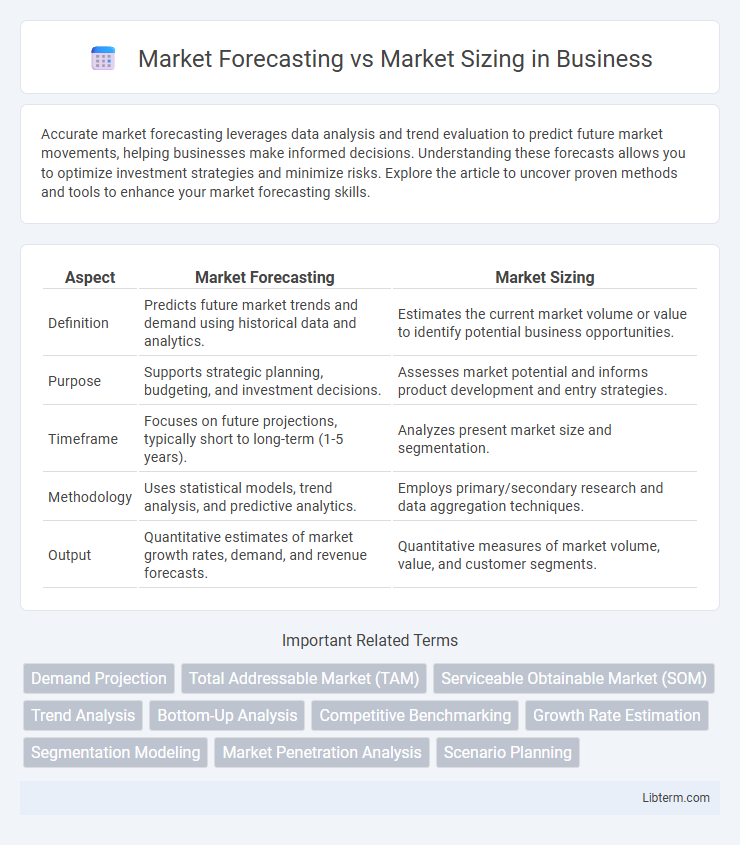Accurate market forecasting leverages data analysis and trend evaluation to predict future market movements, helping businesses make informed decisions. Understanding these forecasts allows you to optimize investment strategies and minimize risks. Explore the article to uncover proven methods and tools to enhance your market forecasting skills.
Table of Comparison
| Aspect | Market Forecasting | Market Sizing |
|---|---|---|
| Definition | Predicts future market trends and demand using historical data and analytics. | Estimates the current market volume or value to identify potential business opportunities. |
| Purpose | Supports strategic planning, budgeting, and investment decisions. | Assesses market potential and informs product development and entry strategies. |
| Timeframe | Focuses on future projections, typically short to long-term (1-5 years). | Analyzes present market size and segmentation. |
| Methodology | Uses statistical models, trend analysis, and predictive analytics. | Employs primary/secondary research and data aggregation techniques. |
| Output | Quantitative estimates of market growth rates, demand, and revenue forecasts. | Quantitative measures of market volume, value, and customer segments. |
Introduction to Market Forecasting and Market Sizing
Market forecasting involves predicting future market trends, demand, and revenue potential based on historical data, economic indicators, and industry analysis to guide strategic business decisions. Market sizing estimates the total potential sales or customer base within a specific market segment, providing a quantitative foundation for evaluating business opportunities and resource allocation. Both techniques use data analytics and market research but serve distinct purposes: forecasting anticipates growth trajectories, while sizing defines the market scope.
Defining Market Forecasting
Market forecasting involves predicting future market trends, demand, and revenue using historical data, statistical models, and economic indicators to guide strategic business decisions. It focuses on estimating market growth rates, sales potentials, and consumer behavior over specific timeframes, enabling companies to allocate resources effectively. Unlike market sizing, which quantifies the current market potential, forecasting aims to anticipate future changes and market dynamics.
Defining Market Sizing
Market sizing quantifies the total potential demand for a product or service within a specific market, helping businesses estimate revenue opportunities and set strategic goals. It involves analyzing factors such as target customer segments, geographic reach, and pricing models to determine market volume and value. Accurate market sizing enables companies to allocate resources effectively and evaluate market entry feasibility compared to market forecasting, which focuses on predicting future market trends and growth rates.
Key Differences: Market Forecasting vs Market Sizing
Market forecasting predicts future market trends, demand, and revenue based on historical data and statistical models, focusing on time-bound projections. Market sizing estimates the total potential market demand or revenue at present, quantifying the overall opportunity without time-specific predictions. Key differences include forecasting's emphasis on temporal trends and future outlook, whereas sizing focuses on current market capacity and scale.
Importance of Market Forecasting in Business Strategy
Market forecasting provides businesses with data-driven insights to predict future market trends, enabling informed decision-making and strategic planning. Accurate market forecasts help companies allocate resources efficiently, anticipate customer demand, and identify growth opportunities, reducing risks associated with market volatility. Integrating market forecasting into business strategy enhances competitive advantage by aligning product development, marketing efforts, and investment decisions with projected market dynamics.
Importance of Market Sizing for Market Entry
Market sizing provides a critical foundation for market entry by quantifying the potential revenue and customer base, enabling businesses to allocate resources effectively and tailor their strategies to target segments. Accurate market sizing minimizes risks by identifying market gaps and demand levels, which guides companies in making informed investment decisions. While market forecasting projects future trends and growth, market sizing offers the essential snapshot of current market capacity necessary for immediate market entry planning.
Data Sources for Market Forecasting and Sizing
Market forecasting relies heavily on historical sales data, economic indicators, and consumer behavior analytics to predict future market trends, ensuring accuracy in demand estimation. Market sizing incorporates diverse data sources such as demographic statistics, industry reports, and competitor analysis to quantify the total addressable market and segment potential customers. Integrating primary research like surveys and secondary data from government databases enhances the reliability of both forecasting and sizing outcomes.
Common Methodologies Used
Market forecasting primarily employs time series analysis, regression models, and machine learning algorithms to predict future market trends based on historical data and current indicators. Market sizing typically uses top-down approaches, bottom-up analyses, and competitor benchmarking to estimate the total addressable market volume and revenue potential. Both methodologies rely heavily on primary research, surveys, and secondary data sources to validate assumptions and enhance accuracy.
Challenges in Market Forecasting and Sizing
Market forecasting faces challenges such as data volatility, unpredictable consumer behavior, and market disruptions that complicate accurate predictions. Market sizing struggles with data inconsistencies, limited market visibility, and rapidly changing competitive landscapes, which hinder precise estimation of market potential. Both processes require advanced analytical tools and real-time data integration to overcome uncertainties and improve decision-making accuracy.
Best Practices for Accurate Market Analysis
Market forecasting relies on historical data trends and predictive analytics to estimate future market behavior, while market sizing quantifies the current market potential based on demand and revenue metrics. Best practices for accurate market analysis include using reliable and up-to-date data sources, applying advanced statistical models, and segmenting the market for granular insights. Integrating qualitative research with quantitative analysis enhances the robustness and precision of both forecasting and sizing processes.
Market Forecasting Infographic

 libterm.com
libterm.com